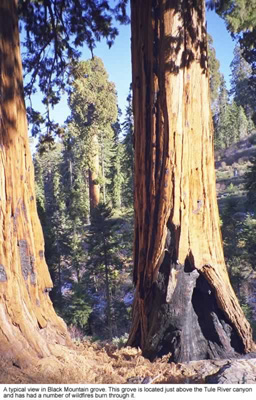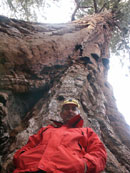Astro 28J: Field Astronomy in the Southern Sierra:
Comet Q4 NEAT
May 14-16, 2004
Another Great Trip! Check the
Highlights Here.
The goal for this course is to focus on the study of comets as we have a very
rare opportunity to see not one but three bright comets passing close to Earth
and sun between late April and early June '04. Comet
Q4 NEAT is expected to provide the best show for northern hemisphere
observers as it races in from the Oort Cloud and passes closest to earth in
early May and then reaches perihelion during our weekend trip May 15. The comet
was discovered in 2001 by the Near
Earth Asteroid Tracking program's automated telescopes at Maui
and Mt. Palomar. A special treat will occur Friday night May 14 as the comet
passes over the outskirts of the Beehive star cluster in Cancer. The comet is
expected to be magnitude 2 and be quite large since it passes so close to earth.
A naked eye comet in one of the brightest star clusters in the sky - a very
nice photo op.
Comet T7 LINEAR will be too far south to see this
weekend, and Comet
F4 Bradfield will be a telescopic object - both objects being best
in the northern hemisphere in late April.
Rare Asteroid Occultation
An additional opportunity occurs at 4:23am Saturday morning as the 9th magnitude
asteroid Massalia
occults a 10th magnitude star in Libra. Our campground turns out
to be centrally located within the well-defined path, so the odds of success
are very high. Gung-ho students are welcome to sacrifice some sleep and join
me for this event. Santa Cruz is on the northern limit. These events are very
scientifically valuable as they are the best way short of a space mission to
get accurate sizes and shapes of asteroids. We will attempt to digitally record
the occultation for precision measurements, all the more important since the
drop in brightness will be only 1/3 magnitude.
Location
I'm leaving some flexibility in the location, since weather can be just about
anything in May - I decided after our Astro
28F trip that spring trips are best done in a dry environment -
the desert or southern Sierra is ideal and most pleasant in the spring. More
coastal areas have too much damp ground and the cool nights make for a problem
with dew'ed optics. I've pretty much settled on the following plan - Sequoia
National Monument will be our prime site. Check out the pictures from a
trip to Sequoia National Monument in May '03.
Sequoia National
Monument.
 A
beautiful area in dry spring weather - I was there for a photo trip last May.
But not good if it's raining, as it's in the front range of the southern Sierra
and catches a lot moisture when frontal systems come through. Along this ridge
runs the Western Divide Highway, at about 6,000 feet elevation, and a number
of campgrounds and forest service roads into secluded spots.
A
beautiful area in dry spring weather - I was there for a photo trip last May.
But not good if it's raining, as it's in the front range of the southern Sierra
and catches a lot moisture when frontal systems come through. Along this ridge
runs the Western Divide Highway, at about 6,000 feet elevation, and a number
of campgrounds and forest service roads into secluded spots.
This area is not far from Johnsondale,
a tiny community on the upper Kern River as it comes down out of the John
Muir Wilderness. The drive up is best reached
via the foothills passing through California Hot Springs, an interesting (developed)
and historic hot springs which still looks and feels much as it was in the 40's
when it was a popular resort for valley folk.
 We need good horizons for astronomy. Tough to find in this forested area and
considering that campgrounds like to be in shady spots. It is legal to camp
anywhere in this area and we'll be near but not in a campground in order to
get the horizons we need. I scouted locations in May of '03. The short list
is down to two locations, both at beautiful meadows similar to the picture at
left. The Astro department lab assistant Dave McKulle will arrive on Thursday
and phone me, at which time I'll post here. If I don't have the info for you
before you leave, check the proposed site at Parker Meadow first. If we're not
there, try Long Meadow, another 4 miles or so farther on, to the northeast.
Comet Q4 NEAT
will be 37 degrees high in the west after twilight ends, at 9pm and should be
visible for a good hour or two if we place our telescopes properly.
We need good horizons for astronomy. Tough to find in this forested area and
considering that campgrounds like to be in shady spots. It is legal to camp
anywhere in this area and we'll be near but not in a campground in order to
get the horizons we need. I scouted locations in May of '03. The short list
is down to two locations, both at beautiful meadows similar to the picture at
left. The Astro department lab assistant Dave McKulle will arrive on Thursday
and phone me, at which time I'll post here. If I don't have the info for you
before you leave, check the proposed site at Parker Meadow first. If we're not
there, try Long Meadow, another 4 miles or so farther on, to the northeast.
Comet Q4 NEAT
will be 37 degrees high in the west after twilight ends, at 9pm and should be
visible for a good hour or two if we place our telescopes properly. I took this picture at the south
end of Parker Meadow. We'll want to be near the north end, shown with the "x"
on this
map. It's a great place for open sky observing. The other possibility
is at Long Meadow. Not the group camp itself, which has no viewing possibilities,
but on the dirt road just past the camp loop which goes out to the north end
of the meadow, shown with the "x" on this
map.
I took this picture at the south
end of Parker Meadow. We'll want to be near the north end, shown with the "x"
on this
map. It's a great place for open sky observing. The other possibility
is at Long Meadow. Not the group camp itself, which has no viewing possibilities,
but on the dirt road just past the camp loop which goes out to the north end
of the meadow, shown with the "x" on this
map. Long Meadow is just a mile from the "Trail
of 100 Giants" - a trail through a grove of giant sequoias
- largest living things on earth. Make no mistake, the trees here are humongous.
The grove is shown as "Long Meadow Grove" on the topo
map, if you click on the 1:100,000 scale option.
Long Meadow is just a mile from the "Trail
of 100 Giants" - a trail through a grove of giant sequoias
- largest living things on earth. Make no mistake, the trees here are humongous.
The grove is shown as "Long Meadow Grove" on the topo
map, if you click on the 1:100,000 scale option.
 For
day activities, we can explore the giant sequoias, study planetary geology while
enjoying the panoramic view of
the Kern River Canyon from Dome Rock
a few miles north of camp, and take a day trip down to the Kern and study the
hot springs right on the
river near the site of spring '03's Astro
28G class. My tentative idea is Saturday after breakfast to go
see the giant sequoia's, followed by a drive down to the Kern River and perhaps
as far as the hot springs
below Lake Isabella - that would be an 80 mile round trip. Then Sunday after
breakfast wrap things up with a lecture at Dome
Rock a short couple of miles north of camp, after breakfast. Or,
we could do the hot springs on the drive home Sunday and spend Saturday with
less driving - whatever the groups decides.
For
day activities, we can explore the giant sequoias, study planetary geology while
enjoying the panoramic view of
the Kern River Canyon from Dome Rock
a few miles north of camp, and take a day trip down to the Kern and study the
hot springs right on the
river near the site of spring '03's Astro
28G class. My tentative idea is Saturday after breakfast to go
see the giant sequoia's, followed by a drive down to the Kern River and perhaps
as far as the hot springs
below Lake Isabella - that would be an 80 mile round trip. Then Sunday after
breakfast wrap things up with a lecture at Dome
Rock a short couple of miles north of camp, after breakfast. Or,
we could do the hot springs on the drive home Sunday and spend Saturday with
less driving - whatever the groups decides.
 A
beautiful area in dry spring weather - I was there for a photo trip last May.
But not good if it's raining, as it's in the front range of the southern Sierra
and catches a lot moisture when frontal systems come through. Along this ridge
runs the Western Divide Highway, at about 6,000 feet elevation, and a number
of campgrounds and forest service roads into secluded spots.
A
beautiful area in dry spring weather - I was there for a photo trip last May.
But not good if it's raining, as it's in the front range of the southern Sierra
and catches a lot moisture when frontal systems come through. Along this ridge
runs the Western Divide Highway, at about 6,000 feet elevation, and a number
of campgrounds and forest service roads into secluded spots. 


